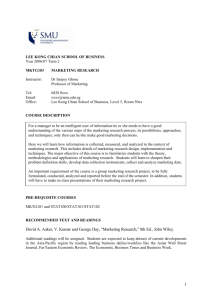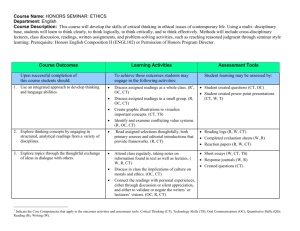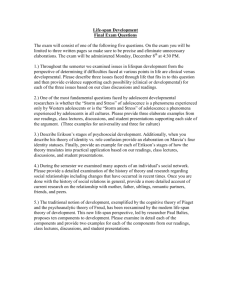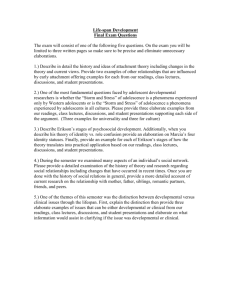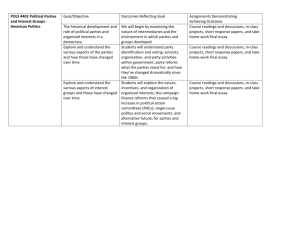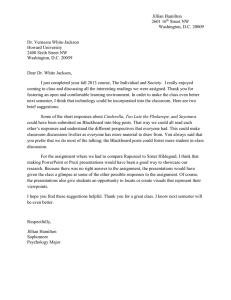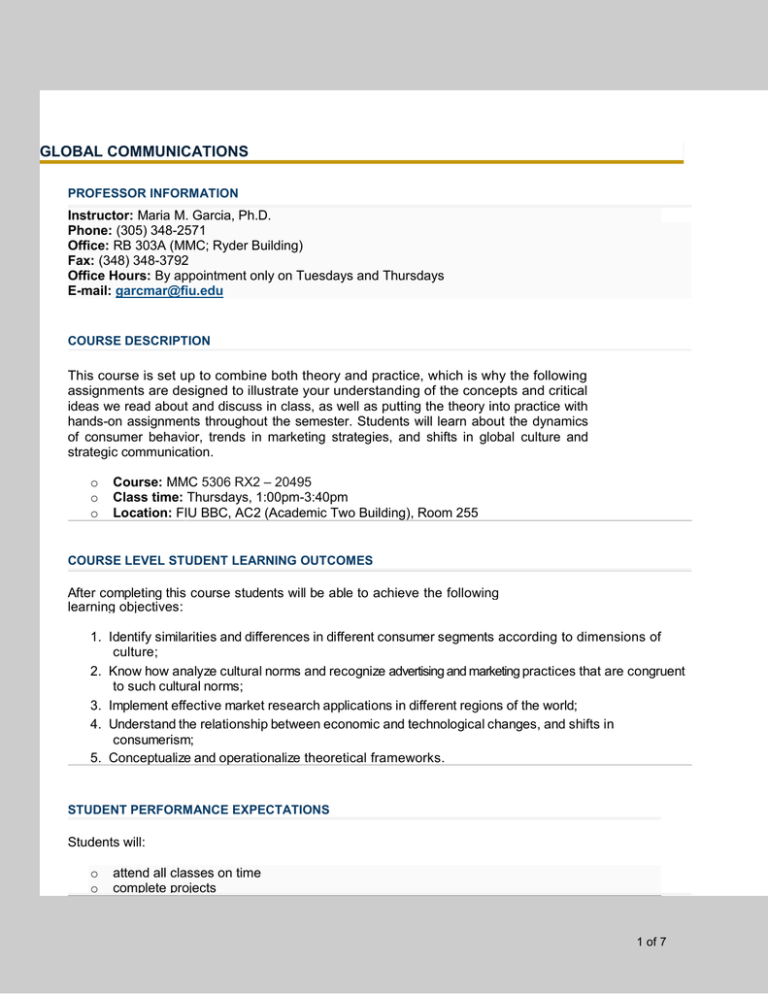
COURSE
SYLLABUS
GLOBAL COMMUNICATIONS
PROFESSOR INFORMATION
Instructor: Maria M. Garcia, Ph.D.
Phone: (305) 348-2571
Office: RB 303A (MMC; Ryder Building)
Fax: (348) 348-3792
Office Hours: By appointment only on Tuesdays and Thursdays
E-mail: garcmar@fiu.edu
COURSE DESCRIPTION
This course is set up to combine both theory and practice, which is why the following
assignments are designed to illustrate your understanding of the concepts and critical
ideas we read about and discuss in class, as well as putting the theory into practice with
hands-on assignments throughout the semester. Students will learn about the dynamics
of consumer behavior, trends in marketing strategies, and shifts in global culture and
strategic communication.
o
o
o
Course: MMC 5306 RX2 – 20495
Class time: Thursdays, 1:00pm-3:40pm
Location: FIU BBC, AC2 (Academic Two Building), Room 255
COURSE LEVEL STUDENT LEARNING OUTCOMES
After completing this course students will be able to achieve the following
learning objectives:
1. Identify similarities and differences in different consumer segments according to dimensions of
culture;
2. Know how analyze cultural norms and recognize advertising and marketing practices that are congruent
to such cultural norms;
3. Implement effective market research applications in different regions of the world;
4. Understand the relationship between economic and technological changes, and shifts in
consumerism;
5. Conceptualize and operationalize theoretical frameworks.
STUDENT PERFORMANCE EXPECTATIONS
Students will:
o
o
attend all classes on time
complete projects
1 of 7
o
o
o
o
dedicate work to final project in groups outside of class
read chapters before the week they are covered and take notes to recap
apply critical analyses of readings to class discussions and final project
present topics in a professional and engaging manner
MAJOR & CURRICULUM STUDENT LEARNING OUTCOMES TARGETED
Students will:
o learn how to synthesize information from market research data
o develop a deeper understanding of cultural dimensions
o evaluate international advertising and marketing approaches
o analyze readings and discussions
o identify problems and propose solutions
REQUIRED BOOKS
Global Marketing and Advertising: Understanding Cultural
Paradoxes (3rd Edition)
Author: Marieke de Mooij
Publisher: Sage Publications, (2010)
ISBN 10: 1412970415
ISBN 13: 9781412970419
DISABILITY NOTICE
If you have a disability and need assistance, please contact the Disability Resource Center
(University Park: GC190; 305-348-3532) (North Campus: WUC139, 305-919-5345). Upon
contact, the Disability Resource Center will review your request and contact your professors or
other personnel to make arrangements for appropriate modification and/or assistance.
EXPERIENTIAL LEARNING ACTIVITIES
While learning about global communications, students will be exposed to a series of
presentations, lectures and discussions with the use of new media technology. Lessons will be
relayed through various presentation platforms, including traditional face-to-face formats, online
guest seminars, soundslides, YouTube videos, websites and weblogs, and social media.
Students are encouraged to participate in open discussions that relate to the lessons and
reading material taken from the textbook, assigned journal articles and news stories.
TEACHING METHODOLOGY
Lectures, class discussions, in-class exercises, case studies, academic journal readings, and
presentations.
2 of 7
RELIGIOUS HOLIDAYS
The University's policy on religious holy days as stated in the University Catalog and
Student Handbook will be followed in this class. Any student may request to be excused
from class to observe a religious holy day of his or her faith.
ASSURANCE OF LEARNING
Miami Ad School and FIU’s School of Journalism and Mass Communication are committed
to excellence in learning. To learn more about their assurances of learning, refer to each
program’s home page.
SJMC DIVERSITY STATEMENT
The School of Journalism and Mass Communication (SJMC) fosters an environment of
inclusivity and respect for diversity and multiculturalism. The SJMC educates students to
embrace diversity and understand the root causes of discrimination, as well as social, ethnic,
sexual, disability and gender-based exclusion.
COURSE COMMUNICAT ION
One on one communication in this course will take place via email or in person.
The email feature is an external communication tool that allows users to send emails to users
enrolled within the course including the instructor and other students. Emails are sent to
the students' FIU email on record. The email tool is located on the left side course menu
on the Blackboard user interface. Students are encouraged to familiarize themselves with
Blackboard since announcements are often posted on the course page.
There may also be the possibility to use Skype for virtual meetings.
EXAM (1=100 pts.)
There is one exam in this course that is worth 100 points. The exam will consist of multiplechoice questions with a critical thinking essay. The critical thinking question tests students’
abilities to address a real world case scenario by proposing solutions supported from
lessons, readings, and discussions.
GROUP PROJECT & PRESENTATION (1 = 150 pts.)
Working in groups, students are required to conduct a detailed written project (worth 100
points) and deliver a professional and engaging presentation of that project (worth 50
points). The objective of the project is to provide students with hands-on experience in
applying the theories and issues associated with international advertising and marketing.
All group members should be listed on the title page, and the group should create a unique
3 of 7
group name for themselves. Individual scores are based on the overall execution of the final
project, including, but not limited to the merit behind the arguments, concepts, analysis, and
cited sources, and member evaluations. The final project should be submitted via Turnitin
by one group member, usually the editor, before the specified presentation date. There are
no penalties for early submissions. The written project must be in APA style.
Note: A one-page proposal of the group’s intended project must be reviewed by the
professor for approval weeks in advance.
Assignments must be submitted on time. Late submissions will be penalized. Deadlines are
firm. A more detailed outline of the final project will be provided on Blackboard during the
semester, and discussed in class.
SOLO PRESENTATION (1 = 50 pts.)
The solo presentation offers students an opportunity to apply the concepts they have
learned in class to a case study. The presentation is worth 50 points. The presentation will
address the week’s chapter, the theories and concepts, and the overall impact they have on
consumers. Students must offer a critical analysis of a case study, specifically an
agency’s campaigns, that are relevant to the readings. Each student is assessed
according to presentation style, originality, delivery and content substance. A more detailed
outline of presentation expectations will be discussed in class. Keep in mind that there are
very strict judging criteria in place. Thus, it is highly suggested that students practice their
presentations far in advance and prepare to deliver high quality showmanship.
Presentations must deliver smooth transitions between topics/subjects, good presenter
posture, flawless slide designs and layouts, visuals, audience engagement, and
professionalism.
CREATIVE EXERCISES (2 = 200 pts.)
There are two creative exercises in this course that are each worth 100 points. The creative
exercises are designed to challenge students to create campaigns or ads for a specific
international market. Students are to present their creative exercises in a formal showcase
and explain why the designs and strategies they have chosen are aligned to their market’s
cultural dynamics. Explanations should correspond to the arguments presented in their
chapter and course readings.
4 of 7
COURSE CALENDAR
Date
Topic
Required Readings
Introduction to the Course / Review of Syllabus
Week 1
Jan 11-17
The Paradoxes of Global Marketing Communications;
Global Branding
Ch 1/2
Supports Learning Objectives: 1, 2, 4
Week 2
Jan 18-24
Value and Culture; Dimensions of Culture
Week 3
Jan 25-31
Culture and Consumer Behavior;
Researching and Applying Cultural Values
Supports Learning Objectives: 1, 2, 3
Ch 3/4
Ch 5/6
Supports Learning Objectives: 1, 2, 3, 4, 5
Culture and Communication;
Week 4
Feb 1-7
Alcalde (2009) journal article on Blackboard
Ch 7/article
Supports Learning Objectives: 2, 4, 5
Week 5
Feb 8-14
** Final project proposal due **
Week 6
Feb 15-21
Exam 1 (Chapters 1-6)
Week 7
Feb 22-28
Culture and Media; Culture and Advertising Appeals
Supports Learning Objectives: 1, 2, 3, 4, 5
Exam
Ch 8/9
** Creative Exercise 1 due **
Week 8
Mar 1-7
Culture and Executional Style;
Ch10/article
Witteborn (2007) journal article on Blackboard
Supports Learning Objectives: 1, 2, 4, 5
Week 9
Mar 8-14
Group meet-ups
Week 10
Mar 15-21
From Value Paradox to Strategy
Supports Learning Objectives: 2, 3, 4, 5
** Projects due **
Week 11
Mar 22-28
Journal articles on BB
Supports Learning Objectives: 2, 4, 5
Chapter 11
Project deadline
Articles
5 of 7
Week 12
Mar 29Apr 4
Project group presentations
Supports Learning Objectives: 2, 4, 5
Week 13
Apr 5-11
Project group presentations
Supports Learning Objectives: 2, 4, 5
Week 14
Apr 12-18
** Creative Exercise 2 due **
In-class student presentations
Week 15
Apr 19-25
** Creative Exercise 2 due **
In-class student presentations
Online
Copyright © 1998
2012. All rights
reserved worldwid
Note: The chapters listed in the table above reflect chapters in de Mooij’s (2010) book. Announcements will be
made in class with regards to journal readings. Refer to your Blackboard course page for additional class materials.
DESPITE BEST ATTEMPTS TO FOLLOW THE ABOVE SCHEDULE, IT IS STILL A TENTATIVE PLAN AND
CHANGES MAY BE NECESSARY AS THE SEMESTER UNFOLDS.
6 of 7
Final Grade Distribution
Assessment
Weight
Points
1 Exam
=
20%
100
2 Creative Exercises
=
40%
200
1 Final Group Project
(Written report & presentation)
=
30%
150
1 Solo Presentation
=
10%
50
100%
500
TOTAL
Percentage
Total Points
Letter Grade
94 – 100%
470 - 500
A
90 – 93%
450 - 469
A-
87 – 89%
435 - 449
B+
84 – 86%
420 - 434
B
80 – 83%
400 - 419
B-
77 – 79%
385 - 399
C+
74 – 76%
370 - 384
C
70 – 73%
350 - 369
C-
67 – 69%
335 - 349
D+
65 – 66%
325 - 334
D
61 – 64%
305 – 324
D-
<61%
<304
F
7 of 7


